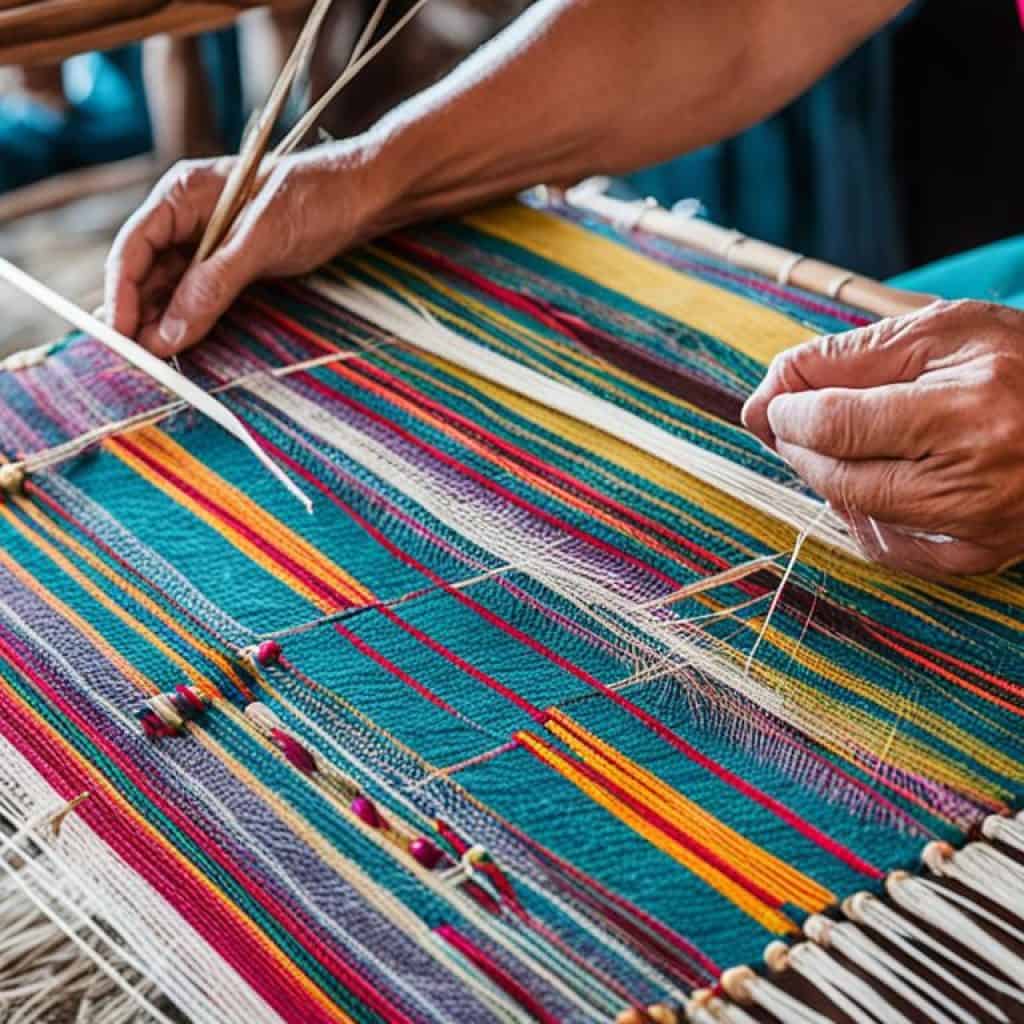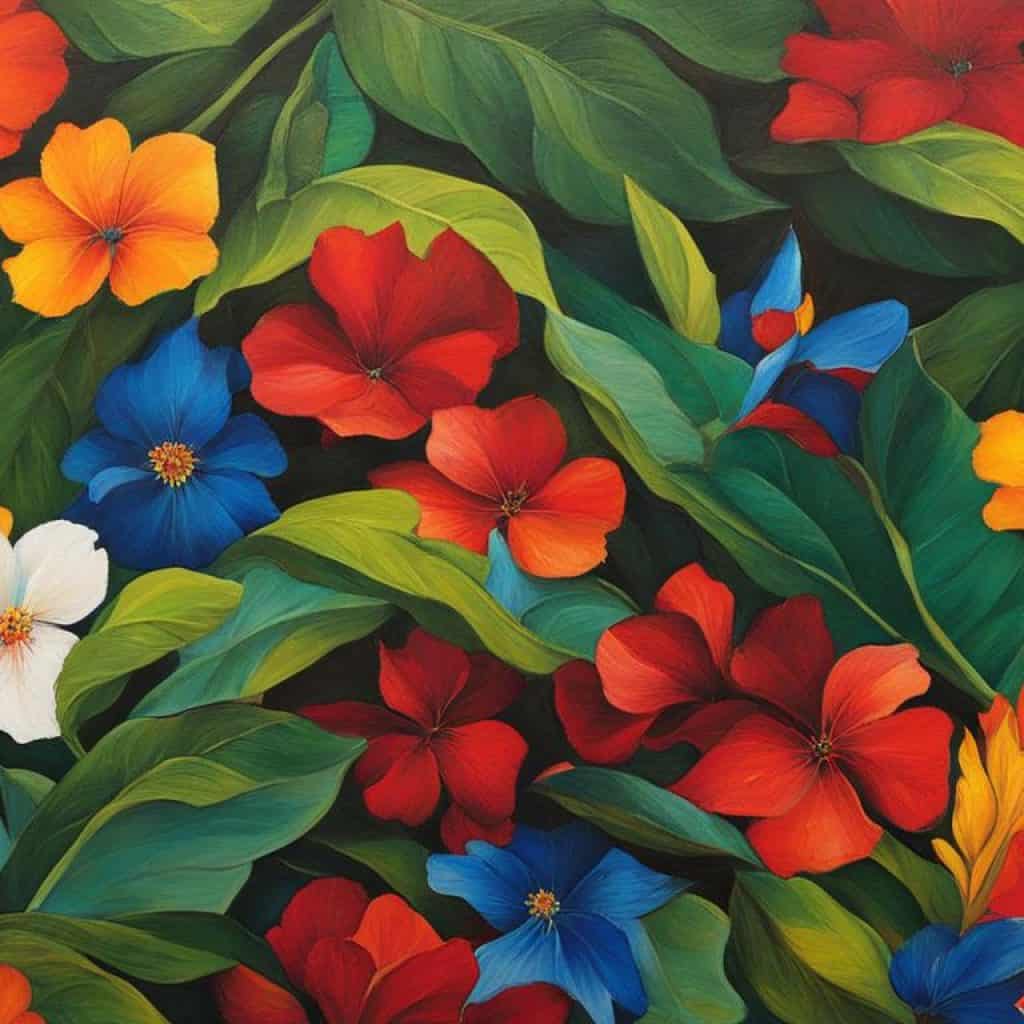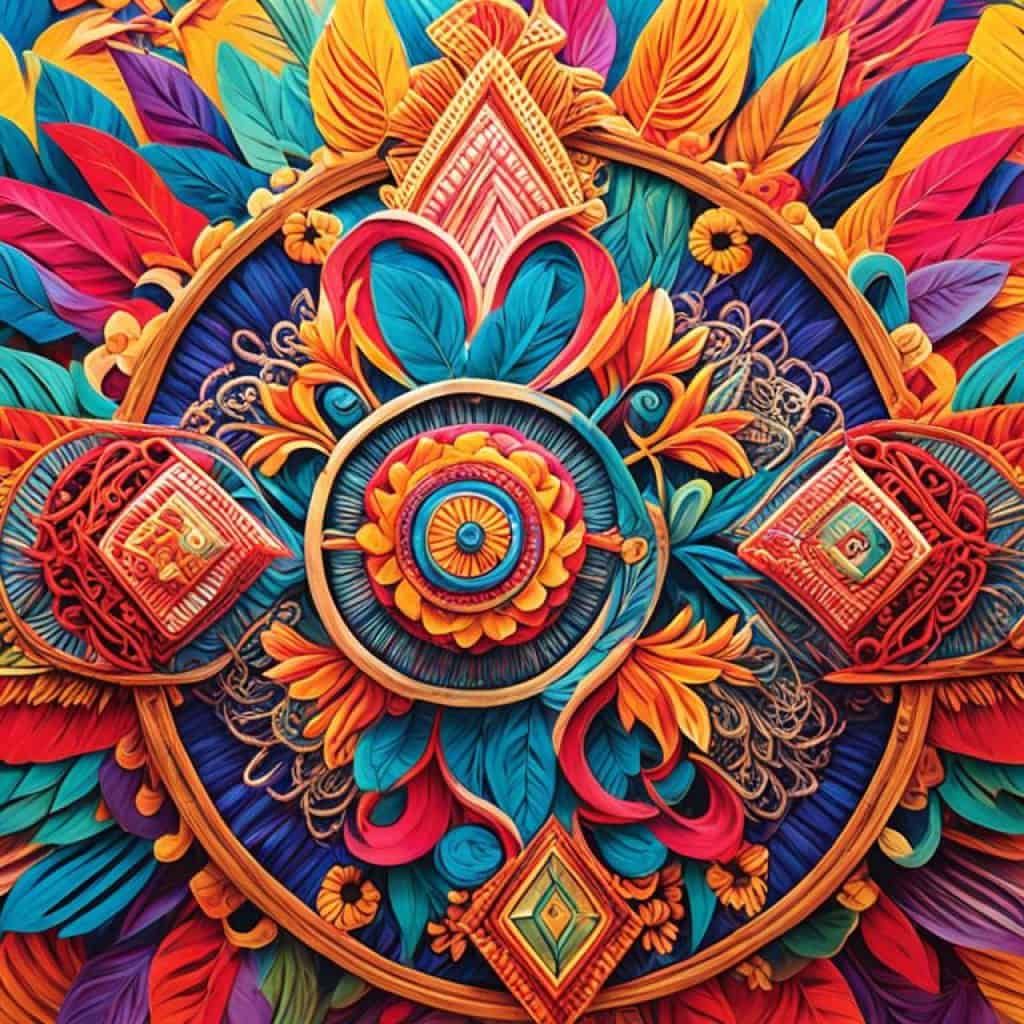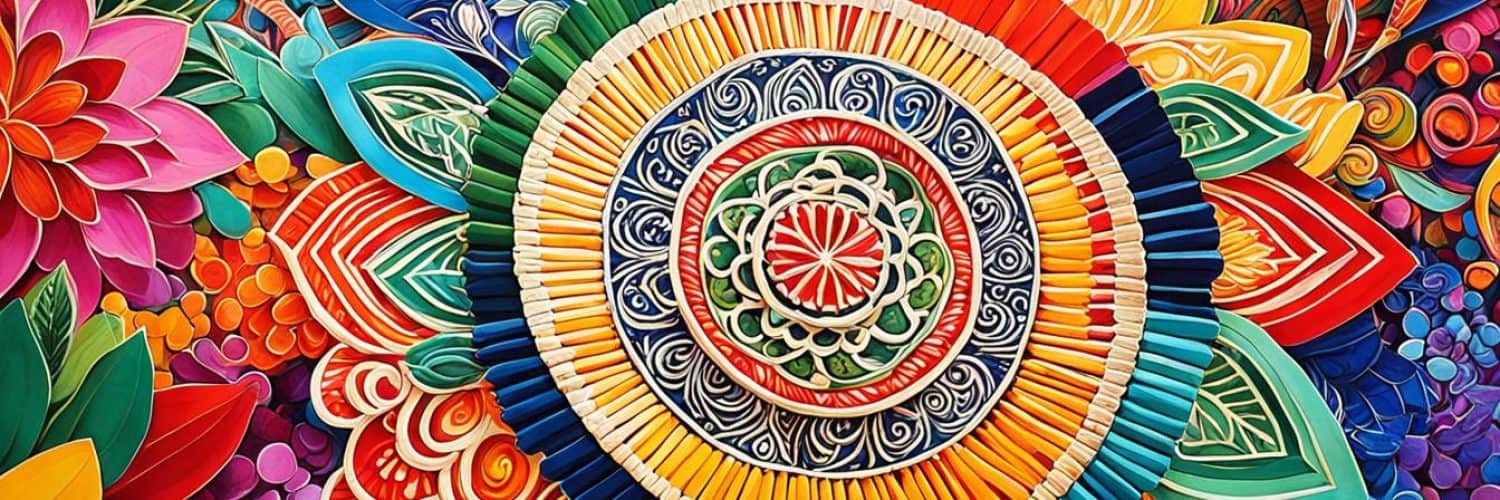Have you ever wondered what lies behind the vibrant and captivating world of Filipino contemporary art? How does it blend traditional aesthetics with modern expressions? And how does it reflect and challenge the societal issues of today? Get ready to uncover the secrets of this intriguing art scene as we dive into the world of contemporary art forms in the Philippines.
Key Takeaways:
- Filipino contemporary art is a fusion of traditional aesthetics and modern expressions.
- Artists in the Philippines use various mediums and techniques to explore social issues and cultural heritage.
- Notable Filipino contemporary artists have made significant contributions to the art scene.
- Art movements have influenced the development and evolution of contemporary art in the Philippines.
- Philippine contemporary art has a profound impact on society and the economy.
Overview of Philippine Contemporary Art
The Philippine contemporary art scene showcases a harmonious blend of traditional and modern elements. Drawing inspiration from indigenous art techniques, Filipino artists infuse their work with a distinctive cultural identity. This fusion of influences results in a diverse range of art styles, including abstract, representational, and mixed media.
Artists explore various mediums, such as painting, sculpture, installation, and digital art, to express their creativity and bring their unique visions to life. Their works delve into a multitude of themes and concepts, reflecting the rich tapestry of Filipino culture and society.

Through their art, contemporary Filipino artists not only push the boundaries of artistic expression but also pay homage to their heritage by engaging with indigenous techniques. This integration of traditional practices creates a vibrant and dynamic art scene that resonates with both local and international audiences.
“The fusion of traditional and modern elements in Philippine contemporary art results in a vibrant and dynamic art scene that reflects the country’s rich cultural heritage.”
Whether it’s the bold strokes of a painting, the intricate details of a sculpture, or the immersive experience of an installation, Philippine contemporary art captivates viewers, encouraging them to reflect, question, and engage in meaningful dialogue.
Notable Philippine Contemporary Artists
Philippine contemporary art is home to several talented artists who have contributed significantly to the art scene. These artists have gained recognition both locally and internationally for their unique styles and thought-provoking work. Let’s take a closer look at some of the notable Philippine contemporary artists:
Benedicto Cabrera, also known as Bencab

Benedicto Cabrera, known by his pseudonym Bencab, is a renowned national artist.
Benedicto Cabrera, commonly known as Bencab, is a celebrated Filipino artist known for his captivating paintings that depict various aspects of Filipino life and social and political landscapes. His works often feature bold brushstrokes and vibrant colors, capturing the essence of Philippine culture and history. Bencab’s art has been exhibited in numerous galleries and museums, both in the Philippines and abroad, solidifying his place as one of the most influential figures in the Philippine contemporary art scene.
Nona Garcia
Nona Garcia is a highly acclaimed artist known for her photorealistic paintings and installations.
Nona Garcia is an accomplished Filipino artist recognized for her mastery of photorealistic painting techniques. Her works often explore themes of memory, identity, and personal histories, creating a captivating visual narrative that resonates with viewers. In addition to paintings, Nona Garcia also experiments with installations, further pushing the boundaries of her artistic expression. Her attention to detail and ability to capture realism in her artworks have established her as a prominent figure in the Philippine contemporary art scene.
Elmer Borlongan
Elmer Borlongan offers a glimpse into everyday Filipino life through his vivid and realistic paintings.
Elmer Borlongan is celebrated for his ability to capture the essence of ordinary Filipino life in his artworks. With his distinctive style characterized by bold lines and vibrant colors, Borlongan’s paintings evoke emotions and tell compelling stories. His realistic portrayals of daily Filipino life, whether rural or urban, create a profound connection with viewers and showcase the beauty in the mundane. Elmer Borlongan’s contributions have left an indelible mark on the Philippine contemporary art scene.
Patricia Perez Eustaquio
Patricia Perez Eustaquio explores themes of decay, desire, and beauty through her interdisciplinary approach.
Patricia Perez Eustaquio is a notable artist known for her interdisciplinary approach to art. She seamlessly weaves together sculpture, painting, and textiles to create thought-provoking pieces that explore concepts of decay, desire, and beauty. Eustaquio’s works often challenge traditional notions of art and invite viewers to reflect on the deeper meaning behind her creations. With her innovative and multi-dimensional approach, Patricia Perez Eustaquio has made a significant impact on the Philippine contemporary art scene.
These artists, along with many others in the Philippine contemporary art scene, have contributed to the richness and diversity of the artistic landscape through their unique perspectives and styles. Their influence continues to shape the future of art in the Philippines and inspire new generations of artists to push boundaries and express themselves creatively.
Prominent Art Movements in the Philippines
The Philippine contemporary art scene has been deeply influenced by various art movements that have shaped its evolution and contributed to its diversity. These art movements have left a profound impact on the artistic landscape, inspiring artists to experiment with new ideas, techniques, and concepts.
Modernism
One of the most prominent art movements in the Philippines is Modernism, which emerged in the mid-20th century. Modernism introduced innovative artistic approaches such as abstraction, expressionism, and cubism to the country. Artists began exploring non-representational forms and experimenting with bold color palettes, expressing their unique perspectives and challenging traditional artistic conventions.
Neo-Realism
Neo-Realism is another significant art movement that emerged in the late 20th century. This movement sought to portray reality from a fresh perspective, often using everyday scenes and common people as subjects. Neo-Realist artworks captured the essence of Philippine life and society, offering glimpses into the daily struggles, joys, and triumphs of the Filipino people. Through their art, Neo-Realist artists aimed to raise awareness about social issues and ignite conversations about the realities of the society they lived in.
Post-Modernism
Post-Modernism had a profound impact on the Philippine contemporary art scene, challenging norms and embracing diversity, contradiction, and multiple perspectives. This movement encouraged artists to experiment with materials, techniques, and hybrid forms of expression. It emphasized the importance of context, cultural references, and the blurring of boundaries between different artistic disciplines. Post-Modernism in the Philippines fostered a sense of artistic freedom and liberation, enabling artists to push beyond conventional boundaries and explore new horizons.
Conceptual Art
Conceptual Art emerged in the late 20th century, prioritizing the idea or concept behind an artwork over its purely visual components. This movement aimed to challenge social, political, and cultural norms through thought-provoking and intellectually stimulating artworks. Conceptual artists in the Philippines used various mediums, including installation, performance, and multimedia, to express their ideas and engage with critical issues. By focusing on ideas rather than traditional artistic techniques, Conceptual Art opened up new possibilities for artistic expression and encouraged viewers to think deeply about the world around them.
The interplay between these art movements has shaped the Philippine contemporary art scene into a dynamic and vibrant ecosystem of artistic expression. Artists continue to draw inspiration from these movements, creating innovative and compelling artworks that reflect the cultural, social, and political landscapes of the Philippines.
How to Appreciate Philippine Contemporary Art
Appreciating Philippine contemporary art doesn’t require expertise. It starts with observing and spending time with the artwork, noticing colors, shapes, textures, and details. Interpreting the artwork is subjective, so consider what it makes you feel and think. Learn more about the artist, the context of the artwork, and the techniques used to gain a deeper understanding. Engage with others to discuss art and gain new perspectives. Remember, art is meant to be enjoyed, so keep an open mind and immerse yourself in the fascinating world of Philippine contemporary art.
Steps to Appreciate Philippine Contemporary Art:
- Observe the artwork: Take the time to closely observe the colors, shapes, textures, and details of the artwork. Pay attention to how these elements contribute to the overall composition.
- Interpretation is subjective: Art evokes different emotions and thoughts in each viewer. Consider what the artwork brings up for you personally and allow yourself to connect with it on a personal level.
- Research and learn: Dive deeper into the artist’s background, the context in which the artwork was created, and the techniques employed. This knowledge can enhance your understanding and appreciation of the piece.
- Engage in discussions: Connect with other art enthusiasts, attend exhibitions, or join online communities to discuss art. Engaging in conversations about art can broaden your perspectives and help you see artworks from different angles.
“Art enables us to find ourselves and lose ourselves at the same time.” – Thomas Merton
By following these steps, you can appreciate and engage with Philippine contemporary art in a meaningful way. Remember that art is a personal experience, and there’s no right or wrong way to appreciate it. Let your curiosity and passion guide you as you explore the fascinating world of Philippine contemporary art.
Here is an example of how to appreciate Philippine contemporary art:
| Artwork | Observation | Interpretation |
|---|---|---|
 |
The artwork features bold, vibrant colors juxtaposed with intricate patterns. | The use of contrasting colors may represent the duality of life, with the patterns symbolizing the complexities and interconnectedness of human experiences. |
Prominent Art Galleries and Museums in the Philippines
The Philippines is home to several prominent art galleries and museums that showcase the best of local contemporary art. These establishments offer visitors a unique opportunity to immerse themselves in the vibrant art scene and experience the rich cultural heritage of the country.
The Metropolitan Museum of Manila is a renowned institution known for its diverse range of exhibitions featuring the works of prominent artists. With its well-curated displays and thought-provoking artworks, the museum offers a fascinating exploration of the Philippines’ contemporary art scene.
The Cultural Center of the Philippines (CCP) is another notable institution that plays a crucial role in promoting contemporary Filipino art. Its galleries provide a platform for both established and emerging artists, showcasing a wide variety of artistic styles and techniques. Visitors can expect to encounter diverse and thought-provoking artworks that reflect the evolving cultural landscape of the Philippines.
Ateneo Art Gallery is a hidden gem situated within the Ateneo de Manila University campus. It houses an impressive collection of Philippine contemporary art, featuring works that encapsulate the country’s rich cultural heritage and artistic expression. With its focus on promoting Filipino artists and their unique perspectives, this gallery offers visitors a distinct and intimate experience.
Pinto Art Museum, located in Antipolo, is renowned for its vast collection of contemporary art pieces by Filipino artists. Set amidst a tranquil and picturesque setting, the museum provides a serene environment for visitors to appreciate the diverse range of artworks. From paintings to sculptures, the exhibits at Pinto Art Museum showcase the breadth and depth of the Philippine contemporary art scene.
Philippine Art Galleries and Museums Comparison Table
| Art Gallery/Museum | Location | Highlights |
|---|---|---|
| The Metropolitan Museum of Manila | Manila | Exhibitions featuring prominent artists |
| The Cultural Center of the Philippines (CCP) | Manila | Platform for established and emerging artists |
| Ateneo Art Gallery | Ateneo de Manila University campus | Impressive collection of Philippine contemporary art |
| Pinto Art Museum | Antipolo | Vast collection of contemporary art pieces |
Whether you’re an art enthusiast or simply curious about the world of Philippine contemporary art, a visit to these prominent art galleries and museums will undoubtedly leave you inspired and enriched. Immerse yourself in the captivating artworks, engage with the vibrant art scene, and gain a deeper understanding of the Philippines’ rich artistic heritage.
Impact of Philippine Contemporary Art in Society
Philippine contemporary art has a profound impact on society, extending beyond aesthetics to raise awareness of pressing social issues. Through its thought-provoking creations, the art form sparks meaningful conversations and challenges societal norms. With its power to elicit critical thinking, Philippine contemporary art encourages diverse perspectives and promotes a deeper understanding of complex subjects such as inequality, human rights, and the environment.
This art form also serves as a vessel for preserving and promoting cultural heritage. By incorporating traditional Filipino art techniques and styles into contemporary works, artists honor their roots and create a bridge between the past and the present. Through this fusion, Philippine contemporary art not only celebrates the rich cultural tapestry of the Philippines but also ensures the preservation of artistic traditions for future generations.
The impact of Philippine contemporary art is not limited to its artistic and cultural significance. The art industry plays a pivotal role in driving economic growth. The sale of artworks, admission fees to galleries and exhibitions, and art tourism significantly contribute to the country’s economy. Furthermore, the vibrant Philippine contemporary art scene attracts visitors from around the world, providing a platform for cultural exchange and fostering international recognition for Filipino artists.
| Impact | Explanation |
|---|---|
| Raises Awareness | Philippine contemporary art serves as a reflection of societal issues, shedding light on topics such as inequality, human rights, and the environment. |
| Encourages Critical Thinking | By presenting multiple perspectives and challenging societal norms, this art form promotes critical thinking and encourages viewers to question and analyze their own beliefs. |
| Preserves Cultural Heritage | Through the incorporation of traditional Filipino art forms and techniques, contemporary artists preserve and promote cultural heritage, ensuring its relevance and longevity. |
| Contributes to the Economy | The art industry, through the sale of artworks, gallery admissions, and art tourism, significantly contributes to the Philippine economy, driving economic growth and providing livelihoods for artists and other professionals in the industry. |
Inspiring Quote:
“Art can change lives and society. It has the power to challenge and provoke, to illuminate and transform. Philippine contemporary art does just that, impacting the hearts and minds of individuals and society as a whole.”
Through its impact on society, Philippine contemporary art continues to inspire, uplift, and contribute to the collective progress of the nation. By addressing vital issues, preserving cultural heritage, and driving economic growth, this art form has secured its place as a vital force in shaping the Filipino identity and engaging audiences worldwide.
Future of Philippine Contemporary Art
The Philippine contemporary art scene is a testament to the dynamic nature of artistic expression in the country. As we look towards the future, it is clear that this vibrant art form will continue to evolve, pushing boundaries, and embracing new possibilities.
One notable shift in the future of Philippine contemporary art is the increasing embrace of digital art. Artists are harnessing the power of technology to create mesmerizing digital paintings and immersive virtual reality installations. This fusion of art and technology opens up limitless possibilities for creativity and experimentation.
Furthermore, there is a growing focus on collaboration and interdisciplinary approaches within the art scene. Artists are bridging different art forms and influences to create unique and thought-provoking works. By transcending traditional boundaries, they are able to explore new perspectives and push the limits of artistic expression.
The future of Philippine contemporary art is also marked by its inclusivity and diversity. Artists from diverse backgrounds and perspectives are making their mark, offering fresh insights and unique narratives. This inclusion of different voices and perspectives adds richness and depth to the art scene, reflecting the rich cultural tapestry of the Philippines.
As technology continues to advance and societal issues evolve, Philippine contemporary art will adapt and innovate, continuously offering fresh perspectives. It will serve as a powerful platform for social commentary, addressing pressing issues and sparking meaningful conversations. The art scene will continue to captivate audiences with its ability to challenge norms, inspire critical thinking, and evoke emotions.
The future of Philippine contemporary art is bright and promising. It will continue to captivate audiences, both locally and globally, with its innovative approaches and powerful narratives. By embracing digital art, collaboration, inclusivity, and evolving with the times, Philippine contemporary art will remain at the forefront of the global art scene, pushing boundaries and inspiring generations to come.
Key Points:
- Artists are embracing digital art and exploring its potential in various forms.
- Collaboration and interdisciplinary approaches are becoming more prevalent within the art scene.
- The art scene is becoming more inclusive and diverse, with artists from different backgrounds and perspectives making their mark.
- As technology advances and societal issues evolve, Philippine contemporary art will continue to adapt and innovate.
Evolution in Philippine Contemporary Art
| Aspect | Evolution |
|---|---|
| Digital Art | Artists embracing digital techniques such as digital painting and virtual reality installations. |
| Collaboration | Increasing focus on interdisciplinary approaches and collaboration between artists from different backgrounds. |
| Inclusivity | Art scene becoming more inclusive and diverse, incorporating voices and perspectives from various communities. |
| Adaptability | Continual adaptation and innovation to reflect advancements in technology and evolving societal issues. |
Conclusion
The Philippine contemporary art scene is a vibrant and dynamic expression of the country’s rich cultural heritage and evolving societal landscape. It brings together the traditional and the modern, creating a unique fusion that captivates audiences. Through a diverse range of art forms and styles, Filipino contemporary artists address social issues and push the boundaries of artistic expression.
Notable artists like Benedicto Cabrera, Nona Garcia, Elmer Borlongan, and Patricia Perez Eustaquio have made significant contributions to the art scene in the Philippines, showcasing their unique perspectives and thought-provoking work. Influenced by movements like Modernism, Neo-Realism, Post-Modernism, and Conceptual Art, the art scene continues to evolve and adapt to societal changes.
Appreciating Philippine contemporary art is accessible to everyone, regardless of expertise. Taking the time to observe and reflect on artworks, learning about the artists and their techniques, and engaging in discussions with others all contribute to a deeper understanding of the art and the stories it tells. The impact of Philippine contemporary art extends beyond aesthetics, shaping society, preserving cultural heritage, and contributing to the country’s economy. With a bright and promising future, Philippine contemporary art continues to captivate audiences worldwide and add to the diversity and vibrancy of the global art scene.


















Add comment